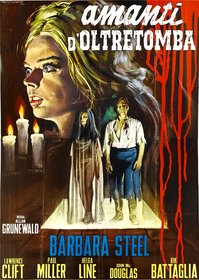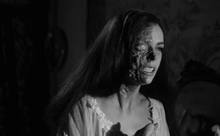Our editor-in-chief Nate Yapp is proud to have contributed to the new book Hidden Horror: A Celebration of 101 Underrated and Overlooked Fright Flicks, edited by Aaron Christensen. Another contributors include Anthony Timpone, B.J. Colangelo, Dave Alexander, Classic-Horror.com's own Robert C. Ring and John W. Bowen. Pick up a copy today from Amazon.com!
Nightmare Castle (1965)
When you look at the history of horror cinema, there are few actors whose name is synonymous with an entire sub-genre. There's perhaps Boris Karloff and the mad scientist film or Christopher Lee in the Dracula/vampire realm. There's one actor who doesn't often get mentioned amongst the elite group of horror icons, and that's Barbara Steele. With her exotic, striking beauty and graceful physicality, she could move from playing icy villainess to strong but vulnerable heroine with incredible ease. Steele's popularity reached its peak in the 1960s with gothic chillers like Pit and the Pendulum (1961) and The Horrible Dr. Hichcock. One of Steele's lesser films is 1965's Nightmare Castle, a visually sumptuous entry that manages to hold interest despite a wildly silly plot.
In a castle in late 19th century Italy, mad scientist Dr. Stephen Arrowsmith (Paul Muller) witnesses his wife Muriel (Steele) cavorting with her lover David, the groundskeeper. Arrowsmith captures, tortures, and then kills the two, removing their hearts from their bodies. It seems the doctor has been using Muriel's wealth to fund experiments having to do with blood, electricity, and life rejuvenation. Before she dies, Muriel reveals that she is tired of the scientist and has written a new will. She's removed him as an heir, instead giving everything to her sister Jenny (Steele again), who is recovering from a breakdown in a nearby asylum. Arrowsmith schemes to get the inheritance by marrying Jenny and getting her re-committed to the asylum by pushing her fragile sanity beyond the breaking point. Aiding him is aged assistant Solange (Helga Line), who wants Muriel's blood for a transfusion that will restore her youth. Apparently, Muriel was a witch whose blood contains restorative properties. Once at the castle, Jenny is plagued with nightmares involving Muriel, leading her and visiting psychiatrist Dr. Joyce (Laurence Clift) to believe that Muriel's spirit has risen to take possession of Jenny and exact a brutal revenge!
The main treat of Nightmare Castle is the dank, creepy atmosphere served up by director Mark Caiano. Teaming with cinematographer Enzo Barboni, Caiano makes effective use of stark black and white photography, dim lighting and shadows, almost wrapping the castle set in an air of gloom and oppression. There's something of a grim pall of death encompassing every cobwebbed inch of the place. Here, Barboni and Caiano bring what would ordinarily be the background elements to a story front and center, presenting, in a way, a possession of the castle by Muriel and David not unlike Muriel's possession of Jenny.
Caiano deserves credit as well for doing the requisite chore of every director of this type of film, and that is to keeping the action moving, either so the audience doesn't look too closely at the plot or to keep them from getting too comfortable in their viewing chair. Whatever the reason, Caiano does well here to insert shock moments or fight scenes at just the right point to keep the dull spots to a minimum. He keeps the love scenes and the dry, static drama scenes to the minimum required to move the story forward. A prime example of this emphasis on action occurs in the film's opening, where one of those few love scenes is interrupted by a moment of brutal violence.
Unfortunately, the plusses the film has with the visuals are nearly undone by a script rife with too many plot devices. The blame here goes to both Caiano and Fabio De Agostini, the writing team for this mess of a story. Spiritual possession, scientific experiments, adultery, and greed are all thrown in with equal measure to create a story that makes little in the way of sense. Like other genre films, horror cinema generally works best when the plot make at least some semblance of sense. Nighmare Castle's plot threads don't even have a modicum of pseudo-logic, becoming nothing more than a series of contrivances. The fact that Muriel is a witch is never given exposition, only briefly being mentioned as a way to further the subplot about Solange's rejuvenation. Also, the electricity part of Arrowsmith's experiments seems to have little to do with the plot except to provide him with a method of killing his victims. There is brief mention of electricity having something to do with his rejuvenation experiments, but when Solange is restored to youth, the only process shown is the blood transfusion!
Steele walks away with the acting honors in Castle, taking full advantage of the solid showcase for her acting ability provided in the dual roles of Muriel and Jenny. There is an inner tough-yet-vulnerable quality that Steele brings to even the most standard heroine roles, and she imbues the Jenny character with it. In Steele's hands, Jenny is less of a fainting, fragile girl and more one who grabs the torch before going into the secret room. She desperately fights to hold on to her individuality as Muriel seeks to control her. At the same time, Steele utilizes hardened eye glares and smooth, deliberate body movements to play Muriel as pure icy evil, relishing only her own self-interests and pleasure and willing to destroy anyone who gets in her way.
The viewing experience for this film was hampered somewhat by an music score that starts out well with moody organ music during the opening credits, then jarringly slaps romantic, sentimental tracks onto many of the movie's scariest moments. This mutes much of the tension generated by those scenes. To be fair, the soundtrack does sound and feel like it was added at the same time the English dubbing was done for the U.S. release. This was a routine practice when it came to distributing foreign-language horror of the 1960s to American audiences. The DVD I viewed was distributed by PC Treasures Incorporated, and is the U.S. 90 minute edit version. There is a 107 minute uncut, but still dubbed, DVD from Severin Films that, I understand, contains more somber, appropriate music accompaniment.
As gothic horror films go, Nightmare Castle is a very good-looking film. To get the most out of the visuals and, at the same time, bypass the incoherent mess of a script while still keeping your sanity, follow my instructions for plot-challenged cinema viewing. Step 1: Place disc in DVD tray. Step 2: Press "Play." Step 3: Mute the volume on your television. If you follow those instructions closely, you'll get through Nightmare Castle, as well as many a summer Hollywood blockbuster, just fine!










Although Solange refers to
Although Solange refers to Muriel as "that witch", she doesn't mean it literally. (she probably meant "witch spelled with a b") There is nothing in the movie to indicate that there's some magical property about Muriel's blood that can rejuvenate Solange. Later in the movie, Solange demands Jenny's blood, and Jenny is definitely not a witch. The script is pretty vague about Solange's condition, but there's a stronger suggestion that there's something about Dr. Arrowsmith's "mad science" that enables Solange to regain her youth.
This movie doesn't get much love these days. I still like it, although I find the middle section (after Jenny's first nightmare) drags. The opening and ending sequences are terrific, though. Someone else had written that the movie seems to be constructed as a valentine to Barbara Steele, since the camera contemplates her every move, and every facial expression throughout. I don't believe that the longer edit released by Severin has a different music score (which was apparently done by Ennio Morricone), although it does have a different opening credits sequence (which may have a different music cue, I'd have to check my copy).
"And might there exist...a guild of witches?" (from Suspiria)
This one almost work, The
This one almost work, The first scenes leading up to Barbara and her lover being tortured to death are pure Gothic horror. Unfortunately the middle of the film is impossibly draggy. If it wasn't for the incredible beauty of Barbara Steele and Helga Line it would be a complete bore. The ending picks up a bit but it's not as effective as the early torture scenes of the two lovers. Without the big payoff in the climax this is a exercise in atmosphere that doesn't pay off. Director Caiano tries his best but he is no Bava. For Barbara Steele fanatics only.
Hmm---is it possible you need
Hmm---is it possible you need to get out of the house a bit more? :?D